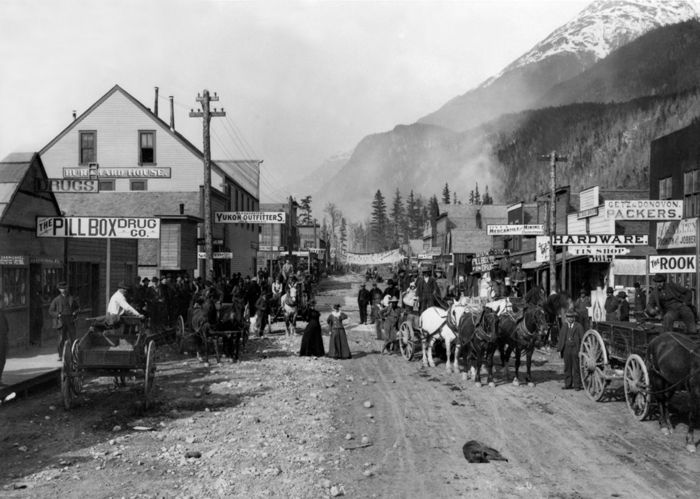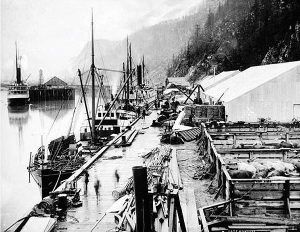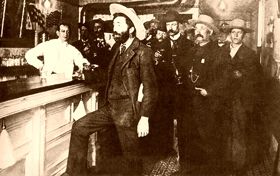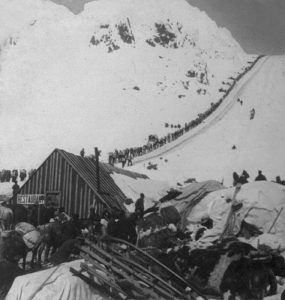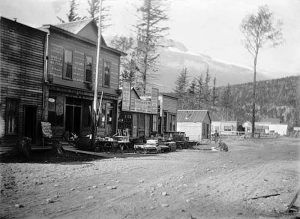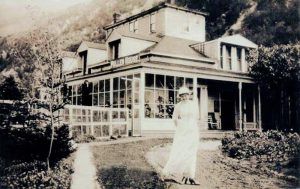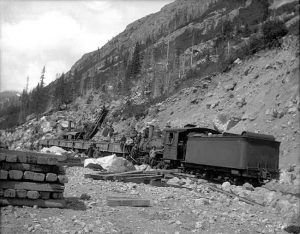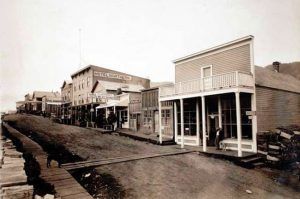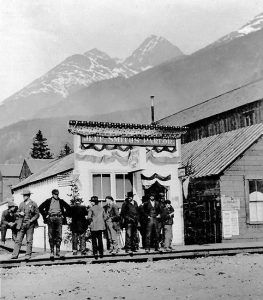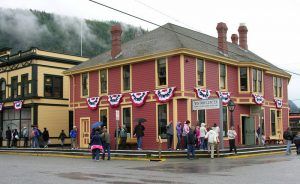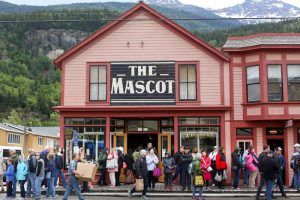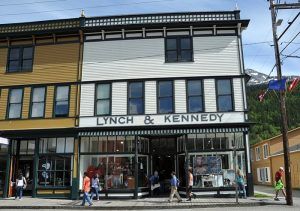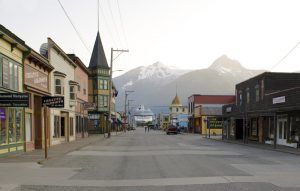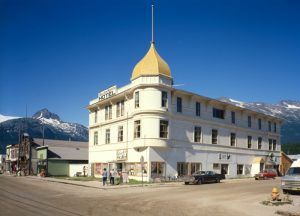Once having a population of nearly 10,000 people, Skagway, Alaska, grew to prominence during the Klondike Gold Rush of 1897.
A few years before the gold rush, William “Billy” Moore, a former steamboat captain, had gone north from British Columbia, Canada. Working for a surveyor, he discovered the White Pass route through the Coast Range and decided a town should be built at the salt-water end of the route, where the Skagway River spilled into Lynn Canal.
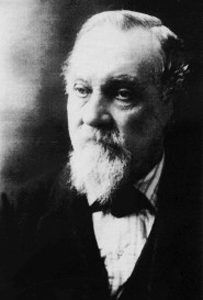
Captain William Moore, Founder of Skagway, Alaska
He filed a 160-acre homestead claim at the head of the White Pass Trail in 1887, and he and his son, Ben, built a cabin, wharf, and sawmill, did some work on the White Pass Trail, and waited for the gold rush Moore was certain would come. They called the town Skagway for the Tlingit Indian name “Skagua,” which means “the place where the north wind blows.”
In August 1896, gold was discovered in the Klondike region, and the first boatload of prospectors landed at Skagway in the summer of 1897. Though he had planned for them to come, Captain Moore and his son, Ben, were pushed aside and ignored by the stampeders. In fact, the newcomers took over the Moore homestead and the surrounding area and laid out a townsite without consulting him. Worse yet, they forced William Moore to move his cabin since it encumbered a newly plotted street.
William Moore had been ignored and humiliated, but he did not give up. Instead, he got busy and extended his wharf to better serve arriving ships. The wharf made money and aided the town’s growth, even though most of the traffic continued to move towards the nearby town of Dyea and the Chilkoot Pass. While Skagway was a place of transit for most people, merchants like Captain James Carroll established enterprises, and government officers like C.L. Andrews, the customs collector, were residents.
All that autumn of 1897 and into the winter, steamers continued disgorging gold-seekers, cattle, horses, tools, food, and villains into Skagway. The town quickly grew to a peak of some 10,000 as stampeders tried to get their required year’s worth of gear and supplies over the Coast Range and down the Yukon River headwaters at Lakes Lindeman and Bennett.
One of the many new arrivals was Jefferson Randolph “Soapy” Smith, a gambler, con artist, and bully from Colorado who boasted he would be the boss of Skagway. By corrupting a U.S. Deputy Marshal, Skagway’s only law enforcer, and posing as civic-minded citizens, Smith and his cohorts took over the fledgling town. He soon established a saloon-gambling den called Jeff Smith’s Parlor and placed men along the trail to steer the unwary into his place. He controlled the businesses and legal system while trying to pass himself off as being kind to animals, kids, and widows.
Between 1897 and 1898, Skagway was a lawless town, described by one member of the North-West Mounted Police as “little better than a hell on earth.” Fights, prostitutes, and liquor were ever-present on Skagway’s streets, and con man “Soapy” Smith, who had risen to considerable power, did little to stop it.
But Smith pushed his luck, and when Soapy’s gang robbed a returning prospector named John Stewart, Stewart said so, loudly and often. Skagway, tired of Soapy by now, held a vigilante meeting to oust him. When he heard of it, Soapy marched down to the meeting carrying a rifle. In July 1898, Frank Reid, the town’s surveyor, challenged Soapy with a pistol. They both fired. Soapy was killed instantly, but his shot hit Reid, who died a few days later. Reid was the hero, but Soapy is best remembered. Both Smith and Reid are interred at the Klondike Gold Rush Cemetery, also known as “Skagway’s Boot Hill.”
Before the gold rush, the Chilkat branch of the Tlingit Indians controlled Chilkoot Pass and monopolized all trade between white traders and Indians of the interior. They also held exclusive rights as packers for prospectors headed over the pass. Matters quickly came to a showdown between the Indians and whites after the stampede began, and the United States Navy was called to keep the peace. Soon, the monopoly was broken, and the Indians were ignored.
The gold seekers used two trails to reach the headwaters of the Yukon River. The 33-mile-long Chilkoot Trail began at nearby Dyea, and the 40-mile White Pass Trail began at Skagway. Thousands of men carried supplies up the Chilkoot Trail, which was too steep for horses, or took the 40-mile White Pass trail to Lake Bennett, where they built boats to float down the Yukon River to Dawson City and the goldfields, 500 miles distant. Chilkoot Pass received most of the publicity and became the most popular of the trails because White Pass was too swampy.
In the meantime, the communities of Skagway and nearby Dyea, located about nine miles to the west, developed from temporary tent cities to towns with many buildings. Each town boasted of its commercial and civic amenities, churches, schools, a newspaper, and government. But, for the next several years, the two towns would vie for dominance.
By October 1897, a Northwest Mounted Police Report described Skagway as having “grown from a concourse of tents to a fair-sized town with well-laid-out streets and numerous frame buildings, stores, saloons, gambling houses, dance houses and a population of about 20,000.” In February 1898, Customs Office records showed that another 5,000 stampeders had landed just in that one month alone.
Some of the prospectors realized how difficult the trek ahead would be to the goldfields and chose to stay behind to supply goods and services to miners. Within weeks, stores, saloons, and offices lined the muddy streets of Skagway. The population was estimated at 8,000 residents during the spring of 1898, with approximately 1,000 prospective miners passing through town each week. By June 1898, with a population between 8,000 and 10,000, Skagway was the largest city in Alaska.
People came, and people left, but some, like Harriet Pullen, put down roots in Skagway. She had been trying to wring a living from a marginal Washington state farm for herself and her four children when the Klondike was struck. In 1897, she joined the Gold Rush, arriving at Skagway with only $7. Soon, her apple pies, baked in a tent, were delighting the men building Billy Moore’s wharf, and she was able to move to a log cabin. For a time, she operated a pack train over White Pass with horses brought up from her Washington farm. Later, she settled down to become Skagway’s most famous hostess. She then bought a large house from William Moore and made the Pullen House the best hotel in town.
In 1898, a 14-mile, steam-operated aerial tramway was constructed up the Skagway side of the White Pass, easing the burden of those able to pay. Tramways also began to operate on the steepest section of the Chilkoot Trail the same year.
In May 1898, the White Pass and Yukon Route railroad began laying narrow gauge railroad tracks in Skagway, and a railroad depot was constructed between September and December 1898. The White Pass & Yukon Route railway paralleled the White Pass Trail. It was completed in 1900.
This destroyed the viability of nearby Dyea, as Skagway had both the deep-water port and the railroad. With the gold rush having declined, only one town was needed to service traffic to the interior.
In 1899, construction on McCabe College began and was completed in 1900. It was the first school in Alaska to offer a college preparatory high school curriculum.
In 1900, Skagway became the first incorporated city in Alaska, and its population was 3,117. But, the gold rush was over, and by 1910, the population had dropped to just 872. The town might have become a ghost town if not for the railroad, which continued to provide freight, fuel, and transportation to Whitehorse and serve several mines in the Yukon.
Much of the history of Skagway was saved by early residents, such as Martin Itjen, who ran a tour bus around the historic town. He was responsible for saving and maintaining the gold rush cemetery from complete loss. He purchased Soapy Smith’s saloon (Jeff Smith’s Parlor) from going the way of the wrecking ball, placed many artifacts of the city’s early history inside, and opened Skagway’s first museum.
Today, six blocks of downtown Skagway comprise a National Historic District, which is part of the Klondike Gold Rush National Historical Park. The National Park manages more than 20 buildings in the Historic District and others just outside its boundary. Four of these buildings serve as museums today, with each sharing a different aspect of gold rush life, from saloons to families to tourism.
Some of these buildings include:
White Pass & Yukon Route Railway Depot and Administration Building Museum – These buildings served as the “home depot” of the railroad until the 1950s. It now serves as the National Park’s visitor center, headquarters, and museum.
The Martin Itjen House – The home of Martin Itjen, the first tourism promotor of Skagway, the building was constructed in 1902. Today it is the home of the park’s partner museum bookstore, Alaska Geographic.
Boas Tailor & Furrier Shop – The first proprietor of this building was Henry Boas. Boas, a tailor and furrier in 1897. It later served to house businesses and retail shops. The cigar store building is leased to a private business. The cigar store building is leased to a private business.
The Mascot Saloon Museum – Probably built sometime in March 1898, it first served as transportation offices. In 1899, it became the Mascotte Saloon. In 1916, Skagway became “dry.” It later served as a drug store and other various purposes until it was acquired by the National Park in 1974 and restored to its 1905-1916 appearance. It now serves as a “saloon” museum.
Verbauwhede’s Cigar Store, Confectionery, and Cribs – More than seven different businesses have operated out of Verbauwhede’s buildings in the last hundred years, but the structures are still much as they appeared when first opened during the Klondike Gold Rush of 1897-1898. Some of these businesses included homes (or “cribs” for prostitutes, a cigar store, lodging, retail stores, businesses, and a gas station. The cigar store building is leased to a private business.
Hern Liquor Store and Pacific Clipper Line Office – The Pacific Clipper Line Office was first housed in this building during the gold rush. It later became part of the Mascot Saloon and a Liquor Store. The cigar store building is leased to a private business.
Jeff Smiths Parlor Museum – One of Skagway’s most prominent buildings, the Jeff Smith Parlor Museum is forever connected to the notorious outlaw Jefferson Randolph “Soapy” Smith. Although Smith led his nefarious band of con men from its cramped rooms, he only occupied the building for three short months before his death in a gunfight. It was built in 1897 and briefly served as a bank before Soapy Smith set up his business in the building. It later served the volunteer fire department and became a museum in 1935.
Lynch and Kennedy Dry Goods Store – The Lynch & Kennedy Store actually started out as an army barracks in 1900, when it was built to house enlisted men in the all-black Company L, 24th Infantry as part of Camp Skagway. In 1908, the building was split in half; one part became the Pack Train Inn and the Trail Saloon, and the other half became the Lynch & Kennedy Store. Later, it served various purposes and became part of the National Park in 1977. The cigar store building is leased to a private business.
The Pantheon Saloon and the Red Front Building – These buildings served as the Hotel Rosalie in 1897, a hardware store in 1898, a paint store, a saloon, and several other purposes through the years. Today it is dedicated to the Junior Ranger program.
The Goldberg Cigar Store – D. Goldberg first operated his store in 1899, which included not only cigars but also confectioneries. It later served as a dry goods store, stood vacant, and was used as storage. In 1978 it was obtained by the National Park Service. It now serves as an exhibit space about women of the gold rush.
The Boss Bakery – This building first served as the Brackett Trading Post in 1897, but the next year became home to the Boss Bakery. Later, the building was used as a grocery store, a cafe, and a harness shop. It was acquired by the National Park in 1978. It currently serves as the Skagway headquarters of the Chilkoot Trail Center.
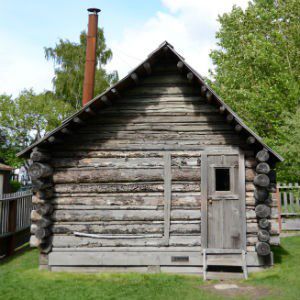
The National Park Service built a replica of the original William Moore Homestead Cabin.
The Moore Homestead Museum – When Captain William Moore and his son J. Bernard “Ben” Moore first established a homestead in Skagway in 1887, they built the Moore Cabin, the first building built in the area. In 1890, Ben married, and he and his wife, Minnie, built a new one-and-a-half-story wood frame house directly in front of their original cabin in 1897. Both the house and the cabin were purchased by the National Park Service in 1977. The buildings now serve as a museum.
The Peniel Mission – The Peniels, a Protestant evangelical humanitarian organization formed in California in the 1880s, established several missions on the West Coast, ministering to both the religious and practical needs of primarily transient people. They arrived in Skagway and first held street meetings outside saloons. In 1900, they built the Peniel Mission. After the Peniel missionaries left, it served the Catholics and later as a residence and an office. The National Park acquired the building in 1978 and restored it to its 1900 exterior condition. Today, it provides housing for Klondike Gold Rush NHP seasonal employees.
The Frye-Bruhn Refrigerated Warehouse – During the early gold rush years, this refrigerated warehouse was associated with one of two businesses that provided retail and wholesale meat to stampeders and commercial clients. Later, it operated as a warehouse for a fruit dealer until the mid-1930s. Afterward, it changed hands several times until it was donated to the National Parks Service.
Today, Skagway is called home to about 1,050 people but doubles in the summer tourist season in order to deal with more than 900,000 visitors.
Skagway is located 90 miles northeast of Juneau at the northernmost end of Lynn Canal or 112 miles south of Whitehorse, Yukon, and just west of the border with British Columbia.
More Information:
Skagway Convention & Visitors Bureau
P.O. Box 1029
Skagway, Alaska 99840
907-983-2854
© Kathy Alexander/Legends of America, updated February 2024.
Also See:
Dyea, Alaska – Ghost Town of the Klondike Gold Rush
Seattle & the Klondike Gold Rush
Sources:
Explore North
History of Alaska-Yukon Mining
Klondike Gold Rush National Historic Park
National Park Service
Wikipedia

